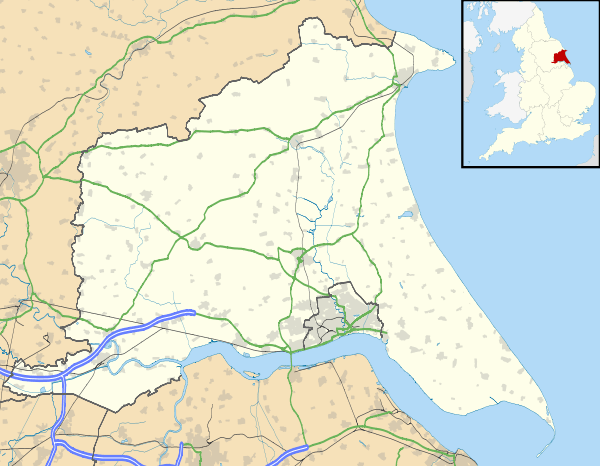Brough Aerodrome
| Brough Aerodrome | |||||||||||||||
|---|---|---|---|---|---|---|---|---|---|---|---|---|---|---|---|
| IATA: none – ICAO: EGNB | |||||||||||||||
| Summary | |||||||||||||||
| Airport type | Private | ||||||||||||||
| Operator | BAE Systems | ||||||||||||||
| Location | Brough, East Riding of Yorkshire | ||||||||||||||
| Elevation AMSL | 12 ft / 4 m | ||||||||||||||
| Coordinates | 53°43′11″N 000°33′59″W / 53.71972°N 0.56639°WCoordinates: 53°43′11″N 000°33′59″W / 53.71972°N 0.56639°W | ||||||||||||||
| Map | |||||||||||||||
 EGNB Location in the East Riding of Yorkshire | |||||||||||||||
| Runways | |||||||||||||||
| |||||||||||||||
Brough Aerodrome (ICAO: EGNB) is located at Brough, East Riding of Yorkshire, England.
The site was first used by the Blackburn Aeroplane & Motor Company during the First World War for the testing of seaplanes.
Brough played its part in preparing fighter pilots for the Battle of Britain. Yorkshire members of The Few – including local Spitfire pilot Ronald Berry and, for a short spell, high-scoring fighter ace James "Ginger" Lacey – honed their flying skills whilst at the Brough Flying Training School on Blackburn B-2 biplanes.
In 1949, the Blackburn Aeroplane & Motor Company changed its name to Blackburn & General Aircraft Limited and built a number of aircraft at Brough, including the Blackburn Beverley transport aircraft and the Blackburn Buccaneer maritime strike aircraft.
Between 1949 and 1957, the perimeter track of the Aerodrome was used as a race track, known famously as the venue of Stirling Moss's first win. The track went under the name of Brough Circuit.
In the 1960s, the company became part of Hawker Siddeley Aviation and the site continued with the production of the Buccaneer.
The company became part of British Aerospace and later BAE Systems and the site continues to build and support military aircraft. Until the end of production, BAE Harrier jump jets were built at Brough. The airfield closed in the early 1990s after the daily shuttle flights to BAe Warton ended due to cost-cutting. Continuing to this day, variants of the BAe Hawk are built at Brough.
On 7 September 2007, however, the company announced that it intended to fly all future Hawk Advanced Jet Trainer aircraft[3] from Brough to Warton at a rate of two per month. It is unsure whether the airfield will become fully operational. On 28 January 2008, flying resumed with the take-off of a demonstration version of the Hawk.[4] At the end of April 2009, an F-35 Lightning II static test airframe arrived at Brough Aerodrome. It is the first such aircraft to be delivered to the UK.[5]
On 27 September 2011, the company announced that it intended the manufacturing of aircraft at Brough to end, effectively closing the world's oldest aircraft factory. A "Battle for Brough" campaign was immediately launched to save the historic site.
Since then, a £2.5 billion deal to provide Typhoons and Hawks to Oman has extended Brough's work backlog to 2016, with hopes of further lucrative export deals to come.[6]
References
- ↑ Airport information for EGNB at World Aero Data. Data current as of October 2006.Source: DAFIF.
- ↑ Airport information for EGNB at Great Circle Mapper. Source: DAFIF (effective October 2006).
- ↑ "The Hawk Advanced Jet Trainer". BAe Systems. 1 July 2008. Retrieved 21 October 2008.
- ↑ "Flights resumed at aircraft base". BBC News Online. BBC. 28 January 2008. Retrieved 13 February 2008.
- ↑ "Joint Strike Fighter Arrives in UK". Royal Navy. Archived from the original on 10 June 2009. Retrieved 21 February 2013.
- ↑ "Brough jobs fight goes on as BAE secures Oman deal". Hull Daily Mail. 22 December 2012. Retrieved 21 February 2013.